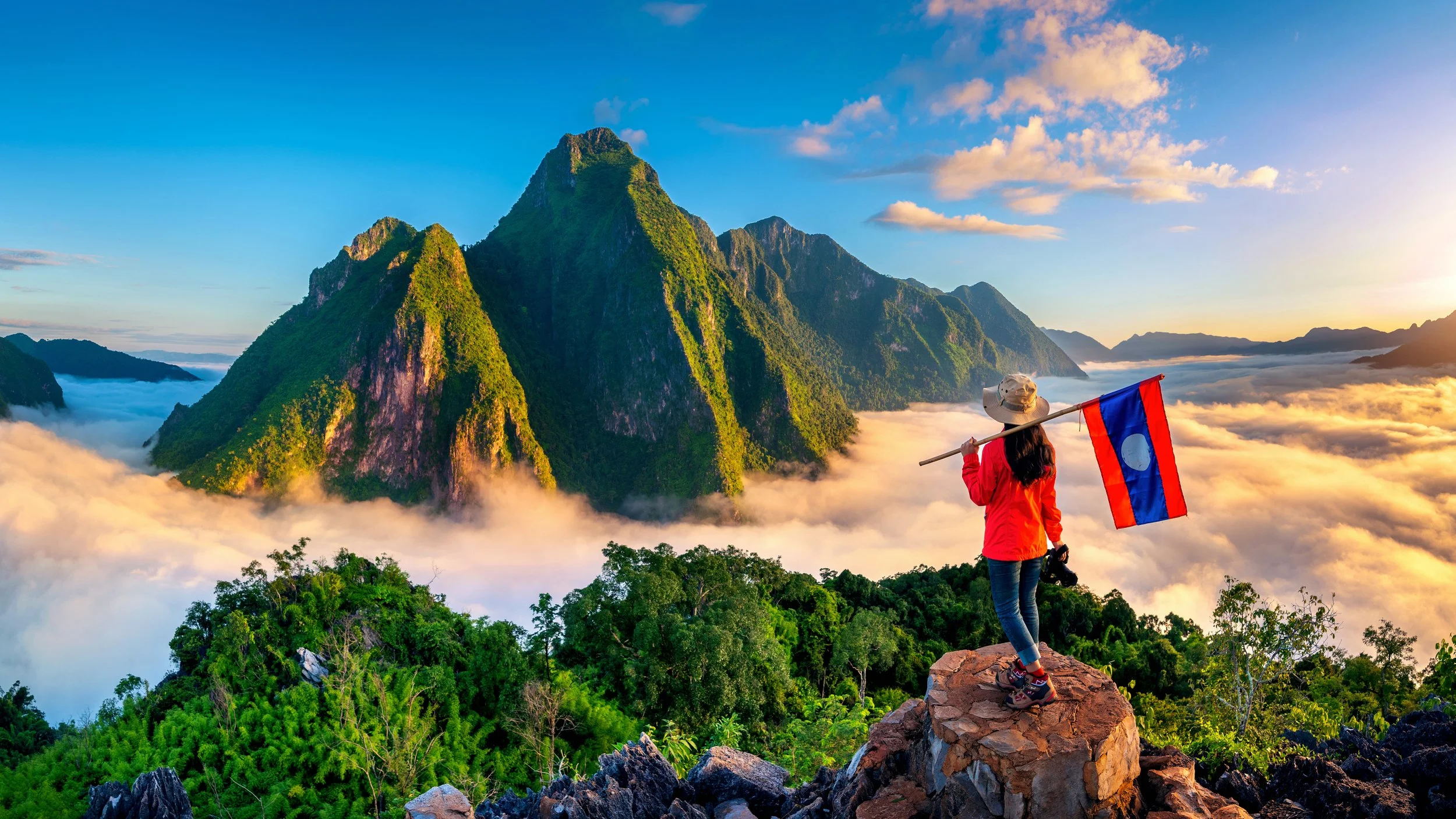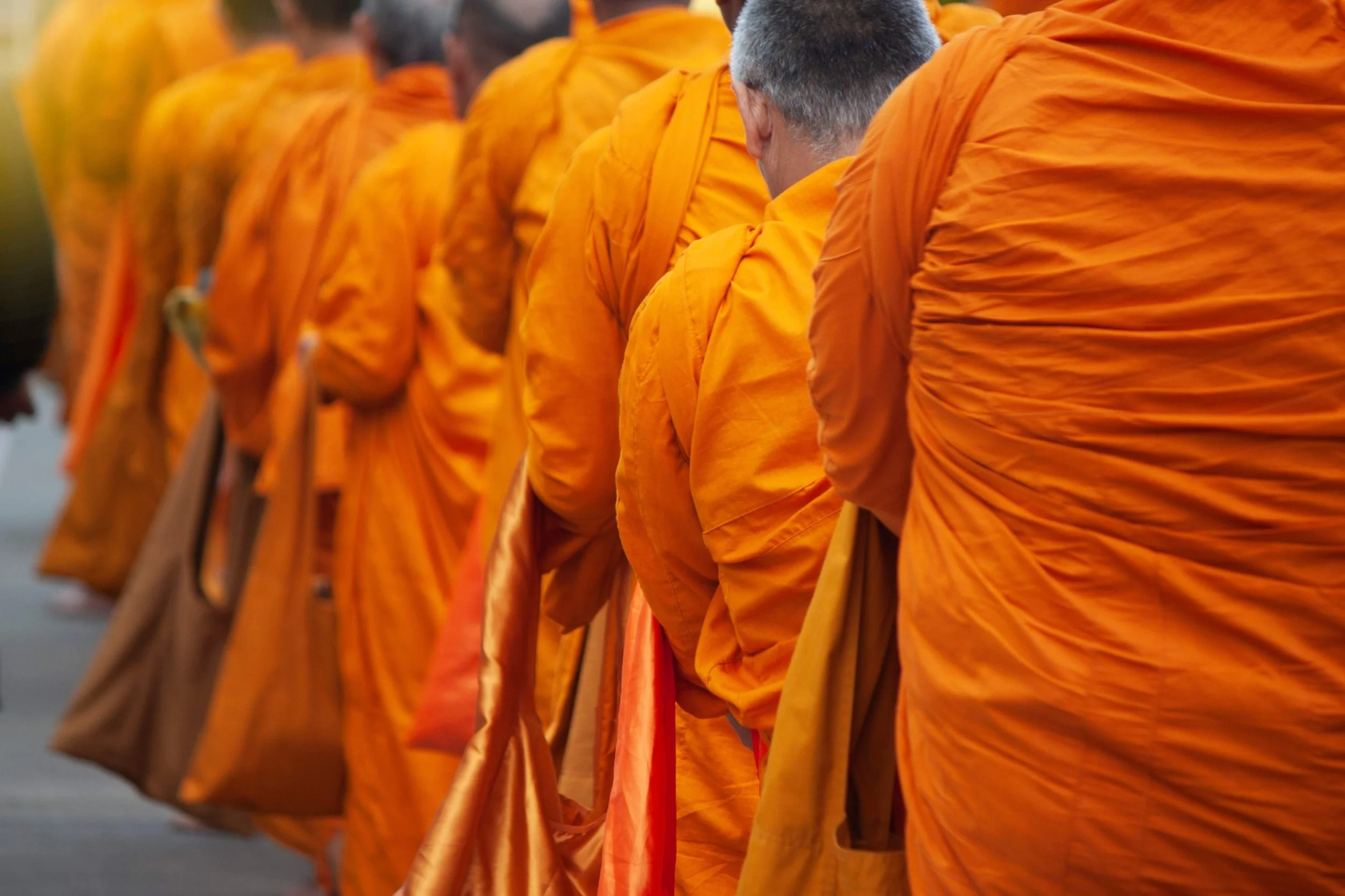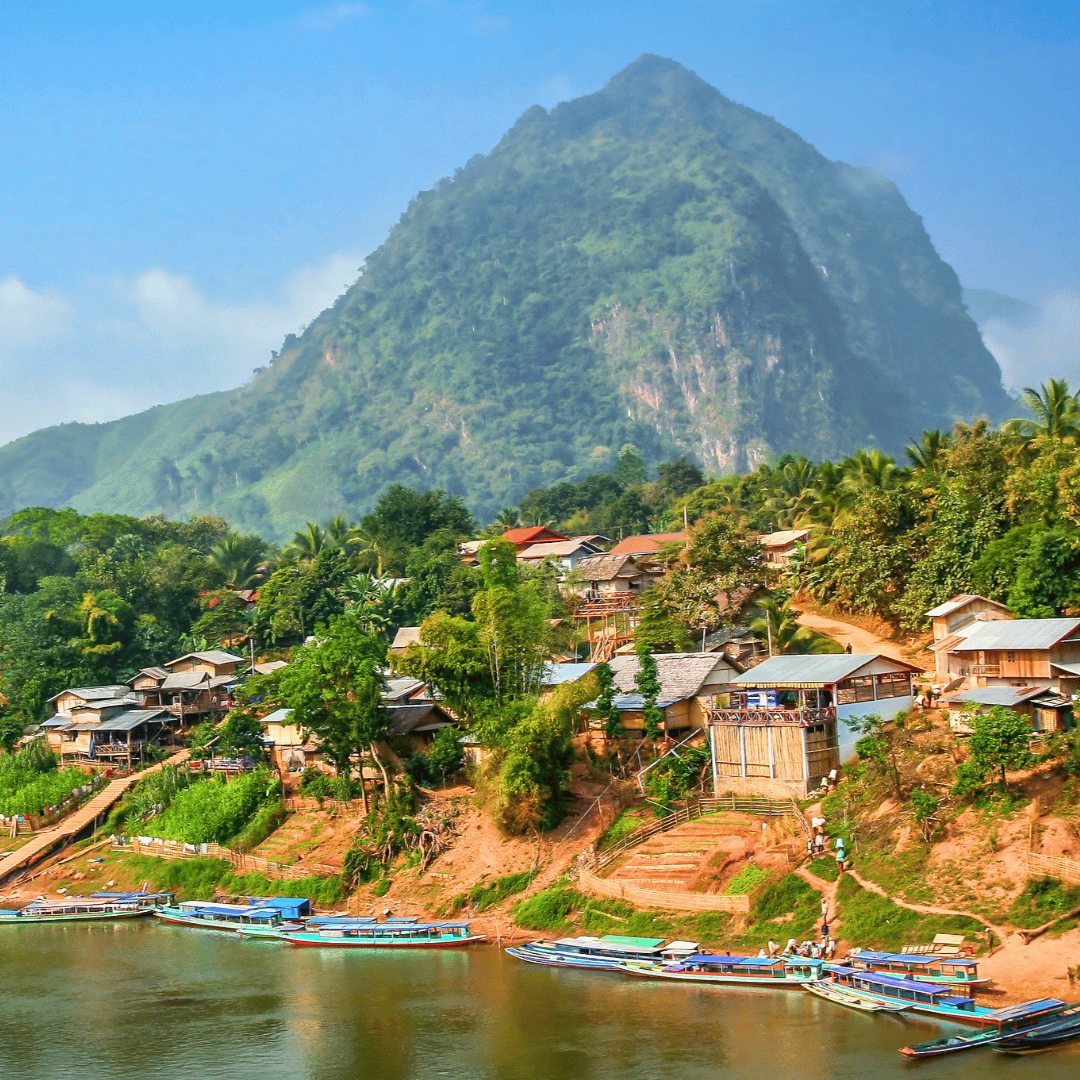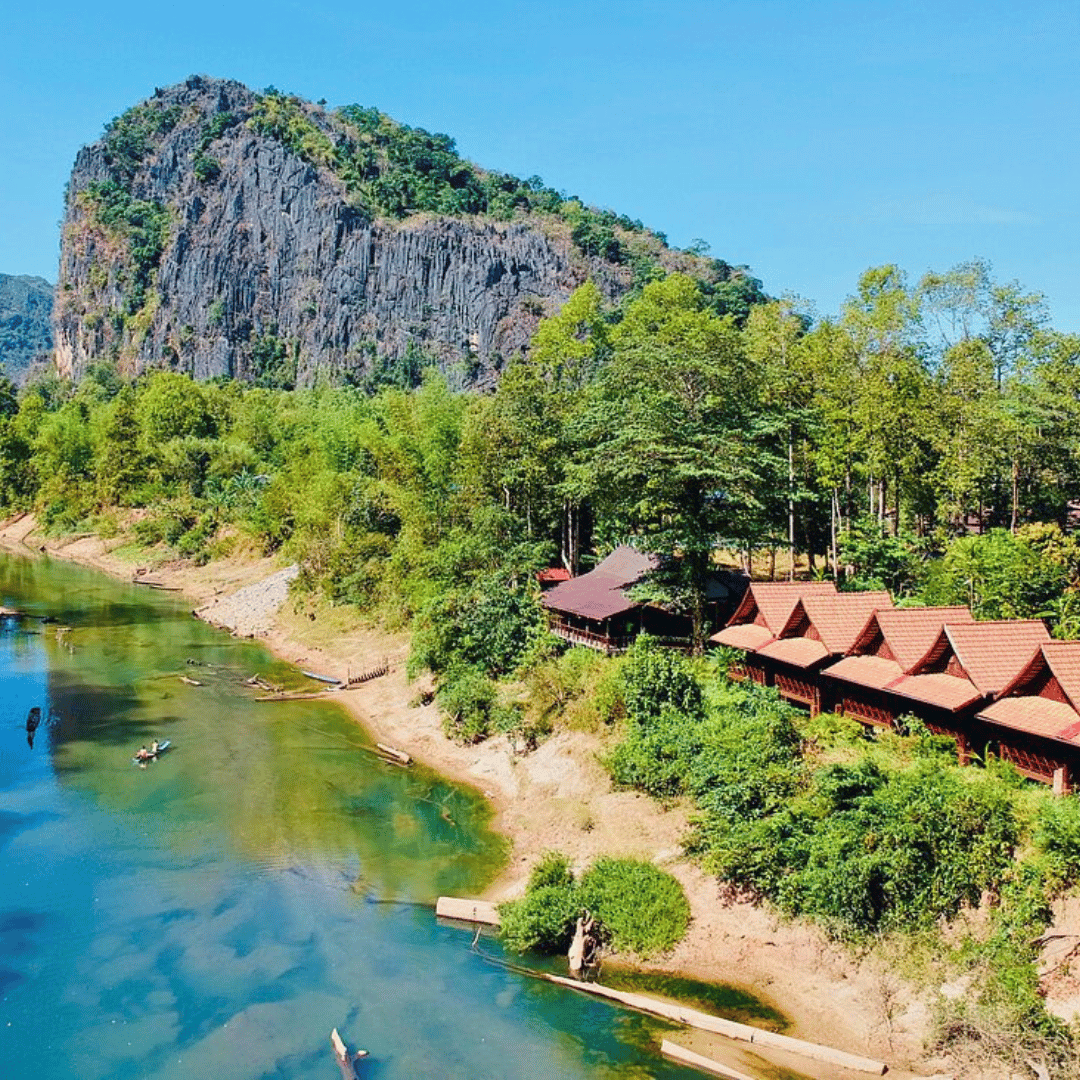
Laos Private Tour Packages
Bespoke Itineraries Designed For Australian Travellers
Laos is a land of Buddhist temples, forested mountains, and winding rivers, offering travellers a slower pace and a glimpse into traditional village life. In Luang Prabang, saffron-robed monks, French-colonial architecture, and nearby waterfalls create a rich cultural base. The Mekong River flows through caves, islands, and river towns, linking the country’s landscapes and communities. In Vang Vieng, limestone karsts rise dramatically above rice paddies, while in the south, the 4000 Islands and ancient Wat Phou highlight Laos’s diverse heritage.
Private tours of Laos can be shaped around your interests, whether that means joining a dawn almsgiving, trekking to remote hill-tribe villages, sampling coffee in the Bolaven Plateau, or cruising between river islands. Travellers may find themselves exploring hidden caves, wandering vibrant markets, or pausing in quiet temples where time seems to stand still. Laos private tour packages offer a flexible and immersive way to connect with the spirit and beauty of this remarkable country. At Asia Unbound, we design private journeys across Asia for Australian travellers seeking flexible, well planned experiences and genuine cultural connection.
Our Best Laos Tour Itineraries
Laos Travel Advice For First Time Visitors
-
Before travelling to Laos, it is worth knowing a few things that will help you enjoy your journey more fully. Laos is still developing compared to some of its neighbours, which is part of its appeal. It offers a quieter, more authentic experience, but this also means infrastructure can be limited. Travel times between destinations are often longer than expected due to the mountainous terrain and winding roads, though the train line between Vientiane and the north has shortened some routes. River travel is also common, with slow boats and private cruises offering scenic but unhurried ways to move around.
Money in Laos is primarily cash-based. The local currency is the kip, and while ATMs are available in major towns, they are less reliable in rural regions. Credit cards are accepted at some hotels and higher-end restaurants, but smaller businesses, markets, and villages usually only take cash, so it is best to plan accordingly.
Culturally, Laos is shaped by Buddhism and a deep sense of community. Respectful behaviour is highly valued, especially when visiting temples and villages. Monks hold a special place in society, and women should avoid touching them or handing items directly. When sitting in a temple, never point your feet at a Buddha image or a monk, and always remove your shoes before entering. The head is considered sacred, so avoid touching anyone’s head, even that of a child. Greeting people with a simple “sabaidee” or using the traditional nop gesture (hands together with a slight bow) will be warmly appreciated. Public displays of affection are uncommon, and it is best to avoid kissing or hugging in public.
Photography should always be approached respectfully. Asking permission before taking photos of people, particularly monks or villagers, shows courtesy and builds trust. In homes and communities, hospitality is deeply valued, and it is polite to accept at least a small amount of food or drink if offered, even if you cannot finish it. Respect for elders is also important in Lao culture, so showing deference in tone and manner is expected.
Laos also has a complex modern history. The “Secret War” left behind unexploded ordnance in some areas, which makes sticking to established paths essential. Visiting places like the COPE Visitor Centre in Vientiane can provide meaningful understanding of this history and the resilience of the Lao people.
Overall, Laos rewards travellers who approach it with patience and openness. Its landscapes, from rivers and rice fields to caves and waterfalls, are best enjoyed at a slower pace, and its people welcome visitors who show interest and respect for their traditions.
-
Laos does not have states in the way that countries like the United States or Australia do. Instead, it is divided into 17 provinces (khoueng) and 1 prefecture (kampheng nakhon), which is the capital city, Vientiane. Each province has its own capital town and covers a mix of lowland river valleys, mountain ranges, and rural communities.
The provinces are:
Attapeu
Bokeo
Bolikhamsai
Champasak
Houaphanh
Khammouane
Luang Namtha
Luang Prabang
Oudomxay
Phongsaly
Salavan (Saravan)
Savannakhet
Sekong
Vientiane Province
Xaisomboun (the newest province, created in 2013)
Xayaboury (Sayabouly)
Xieng Khouang
And the special prefecture:
Vientiane Capital (Nakhon Louang Viangchan)
The northern provinces include Phongsaly, known for its rugged terrain and diverse ethnic groups. Luang Namtha is a gateway to ecotourism and trekking. Oudomxay has a mix of Akha and Hmong communities, and Houaphanh is a region of caves, history, and independence heritage. Luang Prabang, a UNESCO World Heritage site, is considered the cultural heart of the country with its ornate temples and colonial heritage. Xayaboury is famous for elephant conservation, while Xieng Khouang is home to the mysterious Plain of Jars.
In central Laos, Vientiane Province surrounds the capital region and includes Vang Vieng with its limestone landscapes. Vientiane Capital is its own prefecture, blending Buddhist monuments, French-inspired boulevards, and modern city life. Nearby Bolikhamsai and Khammouane showcase river valleys, caves, and remote national parks. Xaisomboun, created in 2013, is the newest province and remains one of the least visited, with a focus on mountainous scenery.
The southern provinces highlight a different side of Laos. Savannakhet, the largest province, combines colonial towns with Buddhist temples and fertile plains. Champasak is rich in history with the Angkor-era ruins of Wat Phou. The 4000 Islands region, known as Si Phan Don, and the Mekong’s thundering waterfalls define Don Khon and the surrounding areas. Attapeu, Sekong, and Salavan are remote, sparsely populated provinces where traditional ways of life remain strong and nature is largely untouched.
This provincial system reflects the diversity of Laos, with each region offering its own flavour of landscapes, ethnic traditions, and cultural sites.
-
The official language of Laos is Lao, sometimes called Laotian. It is a tonal language from the Tai-Kadai family and is closely related to Thai. Speakers of Lao and Thai can often understand each other, particularly along the border where cultural and linguistic ties run deep.
Laos is also home to remarkable linguistic diversity. With more than 80 recognised ethnic groups, many communities speak their own languages or dialects, including Hmong, Khmu, Akha, and Lue. These languages remain strong in rural areas and within families, but Lao serves as the unifying national language for education, media, and government.
Due to Laos’s colonial past, French retains a presence in certain schools, older generations, and some official documents, though it is less common today. English is increasingly widespread in cities and the tourism sector, especially among younger people, but it is still limited in many rural regions. Visitors will find that learning even a few words of Lao is warmly appreciated and often helps break the ice.
Some helpful phrases include:
Sabaidee (sa-bai-dee) - Hello
Khob chai (khawp jai) - Thank you
Chai (chai) - Yes
Bo chai (baw chai) - No
Thao dai? (tao dai) - How much?
Kho thot (khaw thot) - Excuse me / Sorry
Using these simple expressions not only makes travel smoother but also shows respect for local culture. In Laos, where interactions are guided by politeness and friendliness, even a small effort to speak the language can lead to warm smiles and genuine connections.
-
The best time to visit Laos is often considered to be November through March, when the weather is dry, temperatures are more comfortable, and travel is generally easier. Days are warm and pleasant, nights are cooler, and the Mekong River and its tributaries are at navigable levels, making river cruises and boat journeys particularly rewarding. This is the high season for travel, especially in Luang Prabang and Vientiane, so it is wise to book accommodation early if travelling during these months.
From April to June, the weather becomes noticeably hotter, particularly in the lowlands. Temperatures can rise well above 35°C, which can make sightseeing more challenging during the middle of the day. However, mornings and evenings are still enjoyable, and this season coincides with one of the most important events of the year - Pi Mai Lao, or Lao New Year, celebrated in mid-April. Streets fill with processions, rituals, and exuberant water fights that symbolise cleansing and renewal. For travellers who enjoy festivals, this period provides a vibrant cultural experience, despite the heat.
The rainy season runs from May to October, peaking in August and September. Rain usually comes in heavy afternoon downpours rather than lasting all day, leaving plenty of time for exploration. This season transforms the landscape, turning rice paddies bright green, swelling rivers, and bringing waterfalls to their most powerful. Rural travel can be slower during this time due to muddy roads, but many find the scenery and quieter atmosphere well worth it. Accommodation is often more affordable, and destinations that feel crowded in peak season become tranquil again.
Ultimately, the best time to visit Laos depends on what you hope to experience. For cooler weather and reliable transport, the dry months from November to March are ideal. For festivals and cultural vibrancy, April offers a unique atmosphere despite the heat. And for travellers seeking lush landscapes, dramatic waterfalls, and fewer crowds, the rainy months from May to October reveal a side of Laos that feels intimate and alive with colour.
-
When preparing to dress for travel in Laos, it helps to balance practicality for the warm climate with cultural sensitivity. The country has a tropical environment, meaning temperatures are often hot and humid, especially in the lowlands. Lightweight, breathable fabrics such as cotton, linen, or moisture-wicking blends are the most comfortable choices. Loose-fitting clothing not only helps you stay cool but also offers a degree of modesty that aligns with local expectations. A good pair of comfortable walking shoes or sturdy sandals is essential for exploring temples, markets, and rural paths, while flip-flops are convenient for short walks or slipping on and off when entering homes and certain shops.
Cultural awareness is particularly important in Laos, which is a deeply Buddhist country. Modesty is valued, especially when visiting temples, monasteries, and villages. Both men and women should ensure shoulders and knees are covered - long skirts, sarongs, or lightweight trousers paired with shirts that have sleeves are appropriate. Women often carry a light scarf or shawl to quickly cover bare shoulders when entering sacred spaces, and this can also double as a wrap against sun or light rain. For men, collared shirts or neat t-shirts paired with long shorts or trousers are acceptable.
In casual settings such as guesthouses, riverside cafés, or during treks, dress can be more relaxed. However, very revealing clothing is not generally appropriate outside of private resorts or pools. Swimwear should be reserved strictly for swimming areas, and it is best not to walk around towns or villages in beach attire. Laos is more conservative than some of its neighbours, so erring on the side of modesty will always leave a good impression.
Practical extras make a big difference. A wide-brimmed hat, sunglasses, and lightweight rain jacket are useful across seasons, while a shawl or sarong is versatile for covering up, sitting on during picnics, or even using as a blanket on a cool evening. Trekking in the north or on the Bolaven Plateau may bring cooler evenings, so packing a light jumper or long-sleeved top is recommended.
Overall, dressing respectfully in Laos not only ensures you feel comfortable in the climate but also shows cultural awareness. Lao people are warm and welcoming, and visitors who make an effort to dress with modesty and consideration will often find their interactions more positive and meaningful.
-
Food in Laos is simple, fresh, and closely tied to the land and river. Meals are often shared and built around seasonal produce, sticky rice, and fragrant herbs. Eating in Laos is as much about community as it is about flavour, and trying local dishes is one of the best ways to connect with daily life.
The national staple is sticky rice (khao niao), usually served in a small woven basket and eaten with the hands. It accompanies almost every meal and is used to scoop up sauces, dips, and curries. A classic partner is laap (or larb), a minced meat or fish salad mixed with lime, chilli, and fresh herbs, considered the national dish. Another must-try is tam mak hoong, a green papaya salad pounded with chilli, lime, and fermented fish sauce for a punchy, tangy flavour.
Laos also offers hearty soups and noodle dishes. Khao poon is a spicy noodle soup made with chicken or fish, coconut milk, and herbs. Street stalls often serve khao soi, which differs from its Thai cousin by featuring a tomato-based broth. Grilled river fish, chicken, and pork skewers are popular roadside snacks, while or lam, a stew from Luang Prabang, combines vegetables, meat, and aromatic wood herbs for a distinctive taste.
For something lighter, try jeow, a range of dipping sauces made with roasted chillies, tomatoes, or eggplant, eaten with sticky rice and fresh vegetables. Fruit is also abundant - from mangoes and lychees to bananas and pomelos - and often served fresh at markets or pressed into juices.
Laos’s food culture is casual, social, and rooted in freshness. Exploring markets, roadside stalls, and family-run eateries is the best way to sample the variety. While dishes may be spicy, flavours are balanced by fragrant herbs, citrus, and the ever-present sticky rice.
-
How long to spend in Laos really depends on your travel style, but it’s worth remembering that Laos is a country best enjoyed slowly. Distances can be deceiving, transport can take longer than expected, and much of the beauty lies in simply pausing to take in the landscapes and the unhurried rhythm of daily life.
For a short visit of 4 to 5 days, Luang Prabang makes an excellent base. This UNESCO World Heritage town captures the essence of Lao culture with its temples, morning alms-giving, night markets, and colonial architecture. From here, you can take day trips to Kuang Si Waterfall, cruise the Mekong to Pak Ou Caves, or spend time in nearby villages learning traditional crafts. A few days here gives a taste of the country without too much moving around.
With around 7 to 10 days, you can combine Luang Prabang with Vientiane and Vang Vieng. This adds the capital’s temples and French-inspired boulevards, along with Vang Vieng’s limestone cliffs, rice paddies, and river activities. The new train line makes this loop easy to travel, allowing you to see different sides of the country while still keeping a relaxed pace.
If you have two weeks, the journey becomes more rewarding. A popular route includes Luang Prabang, Vang Vieng, Vientiane, and then a flight south to Champasak and the 4000 Islands. This way you can experience both the cultural highlights of the north and the relaxed river life of the south, with the chance to visit ancient Wat Phou, cycle around Don Khon, and witness the thundering Khone Phapheng Falls. Two weeks allows you to move beyond the basics and see how varied Laos really is.
For travellers with three weeks or more, there is time to explore regions often overlooked. In the north, you might trek through Phongsaly or Houaphanh, stay in minority villages, or travel along the Nam Ou River. In the centre, you could explore Kong Lor Cave, Thakhek’s karst scenery, or the Hinboun River valley. In the south, the Bolaven Plateau offers coffee plantations, hidden waterfalls, and cooler mountain air. This longer timeframe allows for slower travel and deeper cultural encounters, making the experience far more immersive.
In summary, a week is enough for a good introduction, two (ish) weeks balances highlights and variety, and three weeks or more lets you see the country in its full depth. No matter how long you stay, embracing the slower pace of life is part of what makes Laos so rewarding.
-
Yes, Laos combines very well with neighbouring countries, and many travellers find that a multi-country itinerary makes the most of their time in South East Asia. Laos is landlocked, bordered by Vietnam, Cambodia, Thailand, and China, which makes it easy to link with other destinations by air, road, or river. Its calm pace and cultural richness also provide a perfect contrast to the energy of its neighbours.
Pairing Laos with Vietnam is one of the most popular options. Direct flights connect Luang Prabang and Vientiane with Hanoi, Ho Chi Minh City, and Da Nang, making it simple to move between the two. A journey could begin in Laos, where you wander through the UNESCO streets of Luang Prabang, cruise the Mekong, and explore limestone karsts in Vang Vieng. From there, flying into Hanoi places you amid bustling old quarters, colonial architecture, and access to Ha Long Bay. Alternatively, travelling south to Ho Chi Minh City brings you into Vietnam’s commercial hub, with easy day trips to the Mekong Delta - offering an interesting comparison to river life in Laos.
Cambodia is another rewarding combination. Flights from Pakse or Vientiane reach Siem Reap in just over an hour, which means you can move from the quiet pace of the 4000 Islands or the historic ruins of Wat Phou in Champasak straight to the monumental temples of Angkor. Both Laos and Cambodia share strong Buddhist traditions, but the way they are expressed is distinct, giving travellers a sense of both cultural continuity and regional diversity. Time in Phnom Penh adds further depth, with its riverfront, Royal Palace, and sobering insights into Cambodia’s modern history.
Planning across countries requires some logistical care, which is why using a specialist such as Asia Unbound is so valuable. With expertise in private, tailor-made journeys, they design seamless itineraries that manage flights, overland transfers, and cross-border details. More importantly, they weave together the highlights of Laos with those of Vietnam or Cambodia at a pace that suits your interests - whether that means in-depth cultural touring, time for relaxation, or a balance of both. This ensures your journey flows smoothly, letting you focus on the experience while every detail is taken care of.
Popular Places To Visit In Laos
Plan Your Laos Itinerary With Asia Unbound
Established in 2007, Unbound Travel Group is a collection of tourism brands specialising in highly curated private touring and small group journeys throughout Asia. With more than two decades of experience, we create bespoke itineraries for discerning travellers looking for a real adventure. Based in Australia, our team uses our on-the-ground experience and first-hand knowledge to carefully curate experiences that are innovative and authentic.
When you start to research a trip to Asia, it’s easy to feel overwhelmed by the seemingly endless possibilities, especially if you don’t want to join a group tour. At Asia Unbound, we’ve made this process easy. We simply need you to tell us relevant information about yourself and the type of travel experience you are looking for - whether it’s a wish list of places you want to visit, a style of travel, a particular interest or theme that you want to explore, or all of these factors. Using this information, we curate a custom-made Asia private tour just for you. It’s that simple.
Laos Hotel Recommendations



















